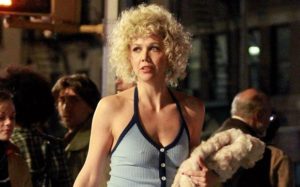
When the Mafia ruled Times Square
HBO’s The Deuce returns for a second season with the Mob in control

The latest television series featuring Mob figures continues this fall with the second season of HBO’s The Deuce, focusing on the sex trade in 1970s New York City.
At the top of that decade’s heap of Manhattan porn purveyors, pimps and prostitutes were the Mob figures who profited from vice. With its raw authenticity, The Deuce stands in eye-opening contrast to many other movies and television shows that make wiseguy profiteering seem noble.
The term “the Deuce” is jargon for the section of 42nd Street near Times Square that became swamped with triple-X theaters and up to 1,200 hookers on weekend nights before civic leaders later cleaned up the area. Today, it’s a family-friendly place that even has a McDonald’s with its trademark name spelled out in Broadway lights.

It wasn’t always that way.
In the early 1970s, New York magazine writer Gail Sheehy brought attention to the area’s problems with stories she wrote after hanging out among prostitutes until 4 a.m., disguised in go-go boots and suede hot pants. She called this type of up-close-and-personal journalism “saturation reporting.”
“I think Americans have always been fascinated by various forms of hustling,” Sheehy has said.
Her magazine work led to the 1973 nonfiction book Hustling: Prostitution in Our Wide Open Society and, two years later, the ABC television movie Hustling, starring Jill Clayburgh as a $30-a-trick prostitute and Lee Remick as a magazine writer based on Sheehy.
After that, public officials began cleaning up the area, but the gritty 1970s version is what The Deuce creators David Simon and George Pelecanos were out to capture, having become interested in the scene after hearing about it from a back-in-the-day habitué who ran a Mob-fronted bar. Sheehy told the New York Post she wasn’t consulted on the program, but Pelecanos has said Sheehy served as the inspiration in season one for a newspaper reporter who shows up where the hookers are, asking questions.
Simon, an author and journalist, and novelist Pelecanos, whom Stephen King calls “perhaps the greatest living American crime writer,” collaborated on an earlier HBO series, The Wire, about the Baltimore streets that Simon had covered as a reporter for the local Sun newspaper. Other popular crime authors in Simon’s sphere, including Richard Price and Megan Abbott, have a hand in this new endeavor.
This team of well-regarded writers, and others who are pitching in now or have in the past, is credited with changing the way crime stories are told on television with the use of realistic dialogue, political subtexts and attention to detail. In The Deuce, for instance, characters consume then-popular products such as diet Tab soft drinks and Parliament cigarettes while navigating through difficult big-city lives without the help of later devices such as smartphones.
Lasting eight episodes on Sunday nights, season one was launched in September 2017, starring James Franco in two roles as twin brothers, one a reckless gambler and the other an unhappily married bartender who becomes entangled with the Mob in paying off his degenerate brother’s bad bets. Franco is back in season two, despite accusations from former acting students of inappropriate or sexually exploitive behavior. According to TV Guide, Simon said the show stuck with Franco “because there have been no complaints about his behavior while filming the HBO series.”

Rounding out this cast of antiheroes on The Deuce are corrupt cops, violent pimps and johns, and abused prostitutes. Maggie Gyllenhaal has a prominent role as a mostly absent mom attempting to transition from battered independent street walker to artistically minded adult movie director at the dawn of relaxed obscenity laws.
Watching these characters slog through their challenging circumstances, some with an enlightened sense of self, is part of what makes this explicit societal snapshot so captivating. The message is clear: Those at the bottom of the power hierarchy (prostitutes) do most of the labor but receive few rewards, while those at the top (Mob figures) make out like the actual bandits they are.
The actors portraying Mafia members do so convincingly, displaying menace but also personality and persuasive persistence, unlike the one-dimensional arrogant hot heads in some stereotypical Mob productions.
Michael Rispoli, who had a part in HBO’s The Sopranos, plays mobster Rudy Pipilo in The Deuce, while actor Garry Pastore, also a Sopranos veteran, is cast as real-life Genovese heavyweight Matthew Joseph “Matty the Horse” Ianniello. According to the New York Times, Ianniello, nicknamed “The Horse” because of his powerful physique, extracted “protection money from bar owners, pornography peddlers and topless dancers during a half-century career that, among other highlights, helped transform Times Square into the dingy world capital of peep shows in the 1960s and ’70s.”
Incidentally, Pastore has a key role as Mafia boss Albert Anastasia in the upcoming independent film Apalachin. This movie revolves around the November 1957 law enforcement raid on a national Mafia summit in Apalachin, New York, about 200 miles northwest of New York City near the Pennsylvania border. The film is set to be released in 2019.
Season two of The Deuce, which began on September 9, moves the story forward from the early 1970s to the late ’70s, with mobsters still serving as the overlords for those running the bordellos, massage parlors and peep shows.
Speaking of that era, Pelecanos said, “The Mafia had their hands in everything.”
Larry Henry is a veteran print and broadcast journalist. He served as press secretary for Nevada Governor Bob Miller, and was political editor at the Las Vegas Sun and managing editor at KFSM-TV, the CBS affiliate in Northwest Arkansas. Henry taught journalism at Haas Hall Academy in Bentonville, Arkansas, and now is the headmaster at the school’s campus in Rogers, Arkansas. The Mob in Pop Culture blog appears monthly.
Feedback or questions? Email blog@themobmuseum.org





